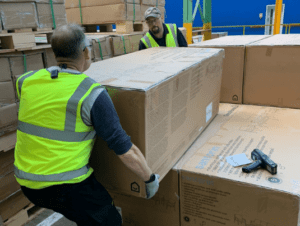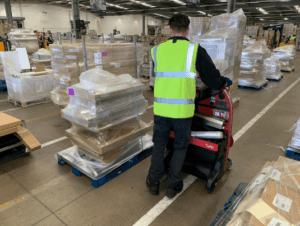case study
Using AI sensors on-the-job to reduce lost time injuries
UK retail warehouse operation, Wincanton, identifies musculoskeletal activity as the fourth highest hazard within its operation. The Wincanton warehouse is primarily responsible for the pick, pack, and dispatch of household, and other ‘awkward’ products directly to the end customer.

20% of all products ranged and delivered are above 15kgs. These products comprise 19% of the lifts that are performed by colleagues across the operation. Furthermore, the significant number of new starters are reliant on shift coaches and with a very large, dispersed site, (around 1 million sq/ft of warehousing split over 4 units).
As part of its safety processes, Wincanton wanted to be able to give movement training to colleagues whilst on the job so they could learn how they were moving whilst working rather than only in a classroom setting. It needed to find a solution that was personal and allowed workers to oversee their own safety.
There was a significant need for formalised continual checking of adherence to manual handling and that:
- Was scalable;
- Gave workers the individual training they needed to move safely – on the job;
- Incited permanent behavioural change;
- Provided formalised monitoring, coaching and support to assess compliance with Manual handling training for:
- New starters;
- Colleagues returning after an incident or injury;
- Colleagues recommencing work after a performance management issue related to manual handling compliance;
- All colleagues at random points across the year.
Wincanton utilised the SoterCoach solution which consisted of a small clip-on sensor that the worker affixed to their hi-vis vest. These devices provided feedback and data to the worker and an online management dashboard that trainers, coaches, and line managers at Wincanton used to appraise the colleague’s technique.
The sensor captured and alerted the workers to any high-risk spine movements via audible and haptic feedback including, lumbar flexion, rotation, static postures, repetitive movements and identified and any high intensity movements. All data was fed back to a communal tablet in the charging docking hub where workers could view their own personal results.
The behavioural change aspect of the sensors’ real-time biofeedback encouraged each worker to internally learn new and correct movement patterns, altering neuromuscular pathways resulting in permanent movement change.
It’s been a fantastic success and what really crystallised it for me was when the sites passed the 250 days without a lost-time injury”, Mark Douglas, Continuous Improvement and Projects Manager, Wincanton.
The Implementation Strategy
Wincanton deployed a soft launch approach to the implementation which resulted in high engagement.
A collection of hand-picked colleagues and safety professionals across the operation were chosen to introduce the technology to a wider audience. This allowed them to speak from a position of experience to colleagues about how it worked, the information they would receive and how it had personally helped them across the two weeks.
The Obstacles
 Typical worker concerns when introducing technology and devices includes:
Typical worker concerns when introducing technology and devices includes:
- Using them as a GPS tracker to see where they were on site;
- Tracking them for performance management;
- Using the data to manage those not improving their results.
To overcome this, Wincanton worked with Soter to clearly understand the sensors and eliminated the use of words like ‘tracker’ or ‘monitoring’ to remove any uncertainty.
Wincanton used information presentations from Soter to explain what applications the technology contained and how the devices were there to support the workers, giving ‘them’ information and coaching on how to move safely.
The firm used examples and compared the devices to a FitBit or Apple Watch that would give them not only data on how they are moving but teach them to move correctly and get to know their body more to stay safe.
The Personal Impact
The data collected was used to provide support and retraining to those colleagues in high-risk groups and easily spot areas in the business that are unsafe and need to be reviewed.
One colleague discussed how personal the technology was to them and indicated that it was a good sign of how Wincanton invested in technology to make their job safer.
Colleagues were unanimous in how easy it was to use and how straightforward and unobtrusive the devices were.
Mark Douglas, Continuous Improvement and Projects Manager, Wincanton discusses, “We have been really pleased and surprised to find colleagues taking it to heart and doing their best to reduce the vibration and haptic feedback alerts that increase awareness of their unsafe movement postures.
“Their considerations have been along the lines of “I can choose to ignore the warnings, but they are there to give me information to help keep me safe so why would I?”. Bringing this technology into our teams has empowered our workers to tell us about their safety”
The outcome
Using the wearables resulted in 250 days without a lost-time injury:
- A reduction in the manual handling risk to Wincanton colleagues across the operation;
- A reduction in the cost of musculoskeletal injury to the business;
- Pioneering a ‘safety first’ culture protecting colleagues when they are at work;
- A reduction in downtime for both colleagues and management.
Wincanton will continue to use the devices, implementing the program into safety processes and have colleagues participate every six months to sustain their improved manual handling postures and stay injury-free.
Using AI sensors on-the-job to reduce lost time injuries
As part of its safety processes, Wincanton wanted to be able to give movement training to colleagues whilst on the job so they could learn how they were moving whilst working rather than only in a classroom setting...
Safety & Health Practitioner
SHP - Health and Safety News, Legislation, PPE, CPD and Resources Related Topics
How will AI transform health and safety?
Drug and alcohol testing in a UK airport environment
Unleashing the power of emerging technologies in EHS


 Typical worker concerns when introducing technology and devices includes:
Typical worker concerns when introducing technology and devices includes: